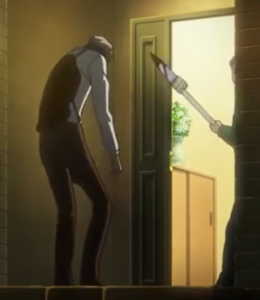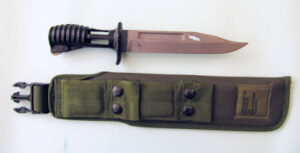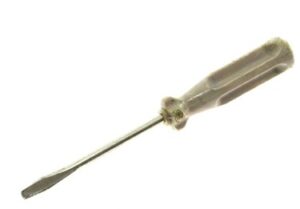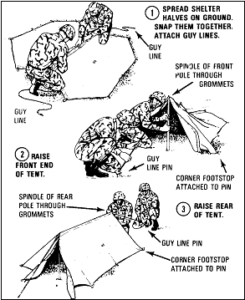Version 2.1
One of the best arguments I have seen against the bayonet was made in Tom Wintringham’s 1940s book “New Ways of War”. Wintringham asserts that the steel used to produce thousands of bayonets could be put to much better wartime purposes, such as the production of submachine guns and grenades. Intriguingly he suggests that only one platoon in a battalion be trained in bayonet fighting. He does not expand further on this idea so we can only conjecture on what special duty, if any, he envisioned for this platoon.
A contemporary of Wintringham’s, John Brophy, argued:
“In this war the armies on both sides possess far more machine guns with a far higher fire power. And I suppose I need not tell anyone that it would be the most insane form of optimism to tackle a tank with a bayonet. All this seems to point unmistakably to the conclusion that the bayonet is obsolete. But the problem is not quite so simple as that. The Home Guard is not going to spend all its time charging at the enemy…. It has to keep guard on thousands of posts throughout the country. It has to put out its sentries, especially by night. And there, I think, we can find a legitimate and important use for the bayonet. It is today first and foremost a sentry's weapon. On the one hand an enemy may creep up on the sentry in the darkness. . . . And that is where the bayonet on the muzzle of the rifle comes into its own. . . . But, used with proper skill, it will enable him to make sure no enemy knifes him or strangles him—and the quiet dispatch of a sentry before he can raise an alarm is always a big advantage to an approaching enemy. That, as I see it, is the chief justification for the retention of the bayonet as a weapon of modern warfare.”

The advocates of the bayonet do have some good arguments in its favour. A prudent course of action may be to treat the bayonet as a special purpose item and have a score or so available to a company. Some of these may be fancy items for parades and demonstrations, others more practical spike bayonets.
It is safe to say, however, that the modern soldier, police officer or civilian is unlikely to have a bayonet fitted when they find themselves using a longarm in close combat. With this in mind the first section of my book “Crash Combat” is entitled “Rifle Fencing” and describes a number of defensive and counter offensive moves that can be made with any longarm, bayoneted or unbayoneted. These moves can also be applied to a spear, staff or any similar improvised weapon such as a shovel or garden fork.
Today’s blog will explore some supplemental subjects. They are written in the context of rifle and bayonet but keep in mind they can be applied to other weapons too.
The basic stance for the bayonet can be considered to be weak-side forward. For a right-handed fighter this means his left foot is advanced and his right hand is towards the rear of the weapon.



The long thrust (above, right) can be thought of as an equivalent to the fencer’s lunge. I use that comparison with some caution, however since it is important not to over-extend this action. The long thrust also has some elements in common with the long knife thrust technique I detail in “Attack, Avoid, Survive”. From the basic stance the soldier steps forward with his rear, strong-side foot. His weak-side leg, which is now to the rear, straightens. His weak-side arm straightens to thrust the bayonet forward. Withdrawing the blade may involve stepping back the strong-side foot or bending the weak-side leg. Readers of my works will recognise the footwork here as constituting a “passing step” in that the rear foot passes forward of the other foot. With the rear leg straightening and providing back-heel thrust there is also a parallel with the forward stance of styles such as karate. A point to stress with the long thrust is not to attempt to overreach. Balance and the capability of rapid follow-up actions are far more important than range.

The short thrust can be made using the “sliding step”, with the weak-side foot advancing first. Bayonets are used during a charge so the short thrust must also be practiced with the strong-side foot forwards.
The 1942 pamphlet for British troops recommends that men practice charging across ground with at least one obstacle. Rifles would be shifted to the on-guard position when 20 yards from the enemy. At 10 yards rifles might be fired at the objective. This was a snap shot with the rifle butt brought up just under the strong-side armpit. To avoid the tendency to shoot high the weapon was therefore fired roughly parallel to the ground.
Some veterans advocate that firing a rifle was an option to free a stuck bayonet.
One disadvantage of the drill method of training for close combat is that actions can become very predictable. American troops were trained to favour the long thrust to the throat so enemies such as the Japanese practiced several countermoves to this eventuality.
One countermove was to lean or step to the side away from the predicable throat thrust. The same action could be combined with a low short thrust against the attacker’s stomach. Readers of my books will recognize that this is a possible application for the capoeira footwork taught by the ginga.
Another countermove involved dropping down so that the rifle butt touched the ground. This can be performed stepping forwards or stepping back. The high throat thrust passes harmlessly overhead and the defender’s bayonet is aimed at the attacker’s stomach. Readers of my book will recognise this as similar in principle to the Passata Sotto and Stocatta knife moves I describe.
The Japanese did not have a monopoly on cunning tricks with the bayonet. Some British troops were taught to knock a charging enemy’s bayonet downwards so that it stuck in the ground. The charging soldier found himself executing an unplanned pole vault. This move would often disarm the soldier and leave his rifle and bayonet conveniently placed to be used against him!


























